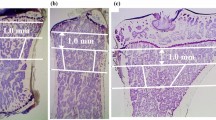Summary
The aim of this investigation was to examine the effect of short-term immobilization on subchondral cortical and trabecular bone tissue in the rat tibia and to determine whether there was any difference when the knee was immobilized in extension or flexion.
Thirty-six male rats were used in this study, and in 18 the knee was fixed in extension and in 18 in flexion. The time of immobilization was for 1, 2 and 3 weeks, with 12 animals in each group and 6 knees in extension and 6 in flexion.
The following parameters were measured: (1) the mean thickness of subchondral and both periosteal cortices; (2) cortical porosity; (3) trabecular bone volume; (4) relative osteoid volume, and (5) relative osteoid surface.
The mean cortical thickness decreased during the period of immobilization and the cortical porosity significantly increased. The trabecular bone volume was unaltered in the first week, but after 3 weeks it had decreased. The relative osteoid volume decreased significantly during the three weeks, and the relative osteoid surface moderately increased.
No relationship was found between the quantitative osteopenic alteration of subchondral bone and the position of immobilization.
Résumé
Le but de ce travail est d'étudier les effets d'une courte immobilisation vis-à-vis de l'os sous-chondral et du tissu spongieux et de rechercher sur le tibia du rat s'il existe une différence selon que le genou est immobilisé en extension ou en flexion. Trente-six rats mâles ont été utilisés pour cette expérimentation, chez 18 d'entre eux le genou a été immobilisé en extension et chez les 18 autres en flexion. L'immobilisation a duré une, deux ou trois semaines, pour trois groupes de 12, la moitié en extension, l'autre en flexion. On a mesuré les paramètres suivants: (1) épaisseur moyenne de l'os sous-chondral et de l'ensemble des corticales; (2) porosité de l'os cortical; (3) volume total de l'os spongieux; (4) volume relatif de l'os ostéoïde et (5) surface relative de l'os ostéoïde. L'épaisseur de l'os sous-chondral diminue pendant la période d'immobilisation tandis que la porosité corticale augmente de façon significative. Le volume du spongieux ne se modifie pas pendant la première semaine mais il commence à diminuer à partir de la troisième semaine. Le volume relatif de l'os ostéoïde diminue significativement au cours des trois semaines, cependant que sa surface relative augmente modérément. On n'a mis en évidence aucune relation entre une ostéopénie mesurable de l'os sous-chondral et la position d'immobilisation.
Similar content being viewed by others
References
Booth FW, Gould EW (1975) Effects of training and disuse on connective tissue. Exerc Sport Sci Rev 3: 83–112
Bordier PJ, Tun-Chot S (1972) Quantitative histology of metabolic bone disease. Clin Endocrinol Metabol 1: 197–215
Chalmers J, Barclay A, Davison AM, MacLeod DAD, Williams DA (1969) Quantitative measurements of osteoid in health and disease. Clin Orthop 63: 169–209
Hattner RS, McMillan DE (1968) Influence of weightlessness upon the skeleton: A review. Aerosp Med 39: 819–855
Kharmoush O, Saville D (1965) The effect of motor denervation on muscle and bone in the rabbit's hind limb. Acta Orthop Scand 36: 361–370
Lips P, Netelenbos JC, Jongen MJM, van Ginkel FC, Althuis AL, van Schaik QL, van der Vijgh WJ, Vermeiden JPW, van der Meer C (1982) Histomorphometric profile and vitamin D status in patients with femoral neck fracture. Metab Bone Dis Rel Res 4: 85–93
Mattson S (1972) The reversibility of disuse osteoporosis. Acta Orthop Scand [Suppl] 144
Meunier PJ, Edouard C, Courpon P, Toussaint F (1975) Morphometric analysis of osteoid in iliac trabecular bone. Methodology. In: Norman AW, Schaefer K, Grigoleif HG, Herrath D von, Ritz E (eds) Vitamin D and problems related to uremic bone disease. Walter de Gruyter, Berlin, pp 149–155
Minaire P, Meunier PJ, Edouard C, Bernard J, Courpen P, Bourret J (1974) Quantitative histological data on disuse osteoporosis. Calcif Tiss Res 17: 57–73
Obrant KJ, Nilsson BE (1984) Histomorphometric changes in the tibial epiphysis after diaphyseal fracture. Clin Orthop 185: 270–275
Pennock JM, Kalu DN, Clark MB, Foster GV, Doyle FH (1972) Hypoplasia of bone indused by immobilization. J Radiol 45: 641–646
Stout SD (1982) The effect of long-term immobilization on the histomorphology of human cortical bone. Calcif Tissue Int 34: 337–342
Uhthoff HK, Jaworski ZGF (1978) Bone loss in response to long-term immobilization. J Bone Joint Surg [Am] 60: 420–429
Author information
Authors and Affiliations
Rights and permissions
About this article
Cite this article
Józsa, L., Réffy, A., Järvinen, M. et al. Cortical and trabecular osteopenia after immobilization. International Orthopaedics 12, 169–172 (1988). https://doi.org/10.1007/BF00266984
Issue Date:
DOI: https://doi.org/10.1007/BF00266984




